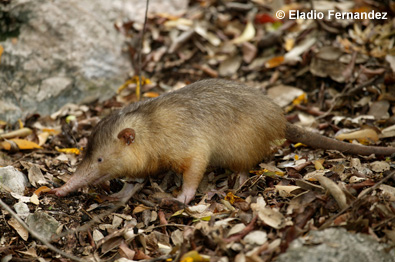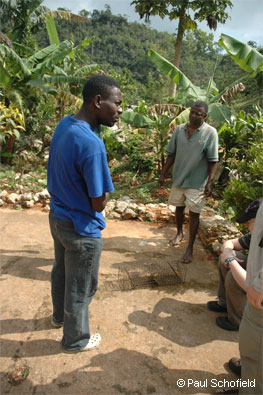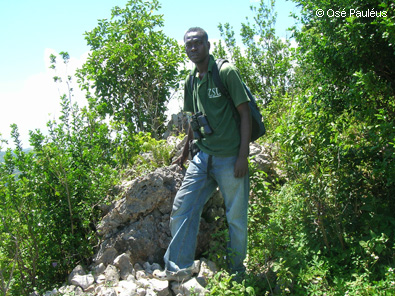Osé is an EDGE Fellow working on conservation of the Hispaniolan solenodon in the Massif de la Hotte, Haiti. Here he reports on some of his findings from recent fieldwork:
The solenodon seen as a pest
As you already know, the Hispaniolan solenodon (Solenodon paradoxus) is endemic to the island of Hispaniola. However, according to the findings of different scientists, in Haiti they can be found only in the Massif de la Hotte. This is for several reasons – because of the elevation, the temperature, the remaining forest area; in one word because of the very special habitat.
Unfortunately, some inhabitants consider the Hispaniolan Solenodon and the Hutia (Isolobodon portoricensis) as pests; others consider them as wild animals that they can hunt and eat. And others barely consider it or don’t even know it as an important species for biodiversity.
A big problem identified up to Duchity (a town in the Massif de la Hotte) and the surrounded communities is that they confuse the hutia and the Hispaniolan solenodon; when you ask them about the “Nez longue” (solenodon), immediately, they refer to hutia; or sometimes some people confuse it with mongoose. We know this because of the description they make and the picture they identified for the solenodon. So, we know that they don’t really make the difference among those three species; especially between the “Zagouti” (hutia) and the “Nez Longue”. That means the work requires a good sense of humour, wisdom, and patience to find accurate information.
When the taro plantation of the subsistence agriculturalists has been devastated by the hutia they think this is the solenodon. According to several people interviewed, a long time ago they used to use dogs and traps to hunt these species because they considered them as pests. Some people even stated that if they could they would kill them. It isn’t that easy to convince them of the importance of the species. So, there is a need for an environmental education program in the region.
Other causes of the decline of the Hispaniolan solenodon
The species have their own predators including mongoose, cats, dogs, and others. Then, the excessive rate of deforestation and the fragmentation of the land for subsistence agriculture is one of the most dangerous threats for the habitat of the solenodon. There are no activities other than agriculture, charcoal making, home construction; all those activities are big factors of deforestation.
Then, from our observation, the birth control can be considered also as a big factor of deforestation. How? The more the population increase, the more the land will be fragmented and the higher the rate of deforestation, because parents tend to separate land to their children before they die. As a matter of fact, a stable community development program in the area will be more than helpful to conserve the habitat of the Hispaniolan solenodon in the wild.
If you would like to support Osé’s work to conserve the Hispaniolan solenodon, please donate here or become an EDGE Champion here.


